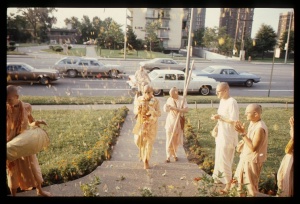CC Madhya 20.175: Difference between revisions
m (1 revision(s)) |
No edit summary |
||
| Line 1: | Line 1: | ||
{{ | [[Category:Sri Caitanya-caritamrta - Madhya-lila Chapter 20|C175]] | ||
<div style="float:left">'''[[Sri Caitanya-caritamrta|Śrī Caitanya-caritāmṛta]] - [[CC Madhya|Madhya-līlā]] - [[CC Madhya 20|Chapter 20: Lord Śrī Caitanya Mahāprabhu Instructs Sanātana Gosvāmī in the Science of the Absolute Truth]]'''</div> | |||
<div style="float:right">[[File:Go-previous.png|link=CC Madhya 20.174|Madhya-līlā 20.174]] '''[[CC Madhya 20.174|Madhya-līlā 20.174]] - [[CC Madhya 20.176|Madhya-līlā 20.176]]''' [[File:Go-next.png|link=CC Madhya 20.176|Madhya-līlā 20.176]]</div> | |||
{{CompareVersions|CC|Madhya 20.175|CC 1975|CC 1996}} | |||
{{RandomImage}} | |||
==== TEXT 175 ==== | ==== TEXT 175 ==== | ||
<div | <div class="verse"> | ||
vaibhava-prakāśa yaiche devakī-tanuja | :vaibhava-prakāśa yaiche devakī-tanuja | ||
dvibhuja-svarūpa kabhu, kabhu haya caturbhuja | :dvibhuja-svarūpa kabhu, kabhu haya caturbhuja | ||
</div> | </div> | ||
| Line 12: | Line 16: | ||
==== SYNONYMS ==== | ==== SYNONYMS ==== | ||
<div | <div class="synonyms"> | ||
vaibhava- | ''vaibhava-prakāśa''—the feature of ''vaibhava-prakāśa''; ''yaiche''—just as; ''devakī-tanuja''—the son of Devakī; ''dvi-bhuja''—two-handed; ''svarūpa''—form; ''kabhu''—sometimes; ''kabhu''—sometimes; ''haya''—is; ''catur-bhuja''—four-handed. | ||
</div> | </div> | ||
| Line 19: | Line 23: | ||
==== TRANSLATION ==== | ==== TRANSLATION ==== | ||
<div | <div class="translation"> | ||
“An example of vaibhava-prakāśa is the son of Devakī. He sometimes has two hands and sometimes four hands. | “An example of vaibhava-prakāśa is the son of Devakī. He sometimes has two hands and sometimes four hands. | ||
</div> | </div> | ||
| Line 26: | Line 30: | ||
==== PURPORT ==== | ==== PURPORT ==== | ||
<div | <div class="purport"> | ||
When Lord Kṛṣṇa took His birth, He appeared outside the womb as four-handed Viṣṇu. Then Devakī and Vasudeva offered their prayers to Him and asked Him to assume His two-handed form. The Lord immediately assumed His two-handed form and ordered that He be transferred to Gokula, on the other side of the river Yamunā. | When Lord Kṛṣṇa took His birth, He appeared outside the womb as four-handed Viṣṇu. Then Devakī and Vasudeva offered their prayers to Him and asked Him to assume His two-handed form. The Lord immediately assumed His two-handed form and ordered that He be transferred to Gokula, on the other side of the river Yamunā. | ||
</div> | </div> | ||
__NOTOC__ | |||
<div style="float:right; clear:both;">[[File:Go-previous.png|link=CC Madhya 20.174|Madhya-līlā 20.174]] '''[[CC Madhya 20.174|Madhya-līlā 20.174]] - [[CC Madhya 20.176|Madhya-līlā 20.176]]''' [[File:Go-next.png|link=CC Madhya 20.176|Madhya-līlā 20.176]]</div> | |||
__NOTOC__ | |||
__NOEDITSECTION__ | |||
Revision as of 03:25, 7 September 2021
Śrī Caitanya-caritāmṛta - Madhya-līlā - Chapter 20: Lord Śrī Caitanya Mahāprabhu Instructs Sanātana Gosvāmī in the Science of the Absolute Truth

His Divine Grace
A.C. Bhaktivedanta Swami Prabhupada
A.C. Bhaktivedanta Swami Prabhupada
TEXT 175
- vaibhava-prakāśa yaiche devakī-tanuja
- dvibhuja-svarūpa kabhu, kabhu haya caturbhuja
SYNONYMS
vaibhava-prakāśa—the feature of vaibhava-prakāśa; yaiche—just as; devakī-tanuja—the son of Devakī; dvi-bhuja—two-handed; svarūpa—form; kabhu—sometimes; kabhu—sometimes; haya—is; catur-bhuja—four-handed.
TRANSLATION
“An example of vaibhava-prakāśa is the son of Devakī. He sometimes has two hands and sometimes four hands.
PURPORT
When Lord Kṛṣṇa took His birth, He appeared outside the womb as four-handed Viṣṇu. Then Devakī and Vasudeva offered their prayers to Him and asked Him to assume His two-handed form. The Lord immediately assumed His two-handed form and ordered that He be transferred to Gokula, on the other side of the river Yamunā.